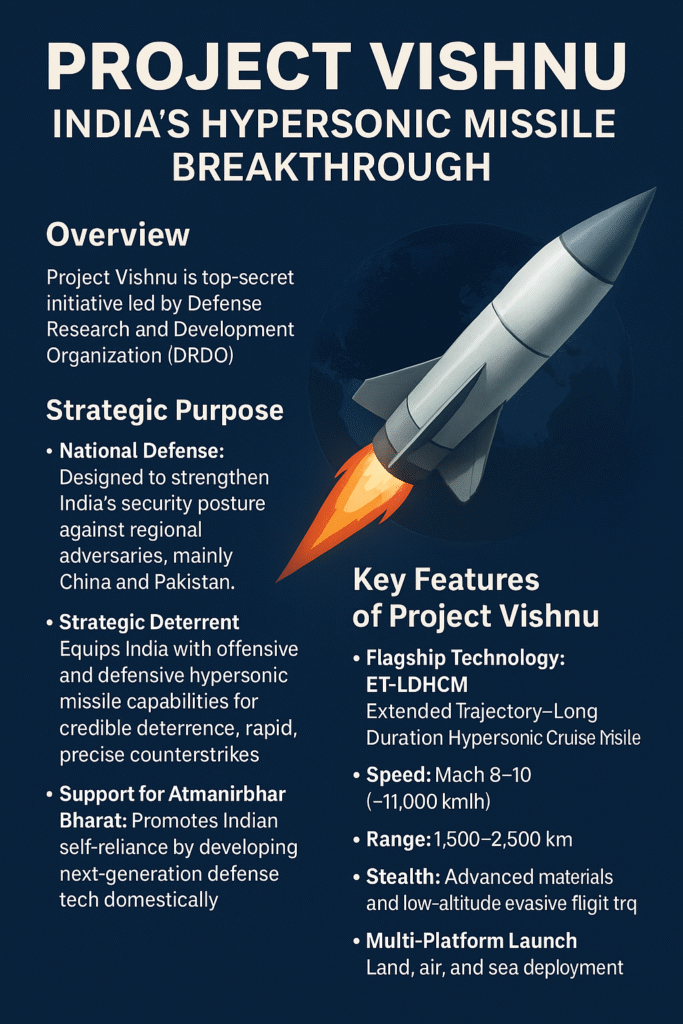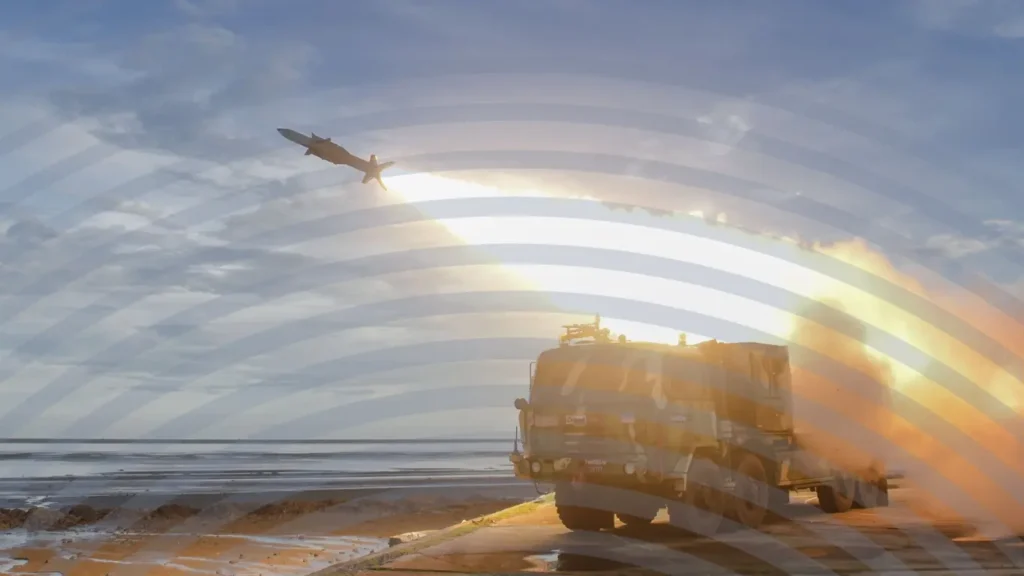
In a major step forward in defense technology, India has successfully entered the hypersonic missile arena with the advancement of Project Vishnu. Spearheaded by the Defence Research and Development Organisation (DRDO), Project Vishnu represents one of the most ambitious military technology programs (India Hypersonic Missile Program) undertaken by India. The program’s core objective is to create a family of indigenous hypersonic cruise missiles that can redefine strategic deterrence and battlefield dominance.
With successful tests in 2025, India has joined the elite group of countries that possess homegrown hypersonic missile systems, putting it on par with nations like the United States, Russia, and China.
Does India have hypersonic missiles? As of 2025, yes, and they are not just prototypes but real, tested systems.
What is Project Vishnu?
Project Vishnu is a top-secret program launched by India in 2023 under DRDO’s strategic weapons initiative. It focuses on designing, testing, and deploying next-generation hypersonic missiles capable of traveling at speeds exceeding Mach 8 to Mach 10, making them virtually impossible to intercept using current missile defense systems.
This project is also a crucial part of Atmanirbhar Bharat, aiming to reduce India’s reliance on foreign military technologies and instead promote domestic innovation and manufacturing in the defense sector.
Strategic Goals of Project Vishnu
- Counter regional threats from nations like China and Pakistan.
- Achieve strategic deterrence through rapid and precise counterstrikes.
- Develop offensive and defensive hypersonic capabilities.
- Integrate cutting-edge technology such as scramjet propulsion and AI-driven guidance systems.
Enhance India’s diplomatic positioning through advanced military capability.

Key Features of India’s Hypersonic Missile: ET-LDHCM
The cornerstone of Project Vishnu is the Extended Trajectory–Long Duration Hypersonic Cruise Missile (ET-LDHCM). This missile system is engineered with next-gen propulsion and targeting systems, making it one of the most formidable weapons developed by India.
Feature | Specification |
Speed | Mach 8–10 (~11,000 km/h) |
Range | 1,500–2,500 km |
Payload | 1,000–2,000 kg (Nuclear/Conventional) |
Propulsion | Scramjet Engine (Indigenous) |
Launch Platforms | Land, Sea, and Air-based systems |
Guidance | AI-assisted targeting and navigation |
Stealth | Radar-evading low altitude trajectory |
Survivability | Thermal protection to withstand 2,000°C+ temperatures |
Technological Milestones
The development of Project Vishnu is backed by breakthrough achievements in multiple areas of military and aerospace technology:
1. Scramjet Propulsion
India has developed a functional scramjet engine that uses atmospheric oxygen for combustion, significantly improving fuel efficiency and allowing sustained hypersonic flight. The engine was successfully tested for over 1,000 seconds in November 2024, showcasing India’s capability in this elite field.
2. Hypersonic Cruise Missile Flight Test
In July 2025, India conducted its first successful test flight of the ET-LDHCM, confirming its operational viability. The missile achieved a speed of Mach 9 and demonstrated precise targeting and evasive maneuvering capabilities.
3. Thermal and Structural Engineering
The missile’s body is constructed using self-healing and oxidation-resistant alloys that can survive temperatures exceeding 2,000°C during flight, allowing sustained high-speed travel without damage.
4. Multi-Platform Integration
The hypersonic system is compatible with:
- Fighter aircraft (air launch)
- Naval destroyers and submarines (sea launch)
- Land-based mobile launchers
This flexibility provides India’s armed forces with strategic deployment options across multiple domains.
Strategic Implications
India’s entry into the hypersonic domain has regional and global consequences.
✅ Regional Deterrence
India’s hypersonic missiles are designed to target deep inside adversarial territories within minutes. This provides a credible counterforce capability, especially critical given China’s advancements in missile technology and Pakistan’s growing tactical arsenal.
✅ Global Standing
India now stands among the four nations that possess operational hypersonic missile systems. This boosts its diplomatic leverage and reinforces its image as a technologically self-sufficient power.
✅ Strategic Response Time
With missiles traveling at 8-10 times the speed of sound, India significantly reduces its response time to hostile actions. This strengthens India’s second-strike capability and overall defense posture.
✅ India’s Defense Doctrine Alignment
The integration of Project Vishnu aligns with India’s doctrine of credible minimum deterrence while providing flexible response options ranging from conventional to nuclear.
Which Countries Have Hypersonic Missiles?
As of 2025, the following countries have demonstrated indigenous hypersonic capabilities:
- United States
- Russia
- China
- India
India is the newest entrant to this elite group, and its ET-LDHCM has shown higher speed and versatility than some systems fielded by China and Russia.
Source: Defense News, The Diplomat, Janes Defence Weekly
India Hypersonic Missile vs Other Systems
India’s previous fastest missile system, BrahMos, has a maximum speed of Mach 3. Project Vishnu’s ET-LDHCM is more than three times faster and designed to evade advanced missile defense systems like the Iron Dome or S-500.
Comparison:
Parameter | BrahMos | ET-LDHCM |
Speed | Mach 2.8–3.0 | Mach 8–10 |
Range | ~300–400 km | 1,500–2,500 km |
Stealth | Moderate | Advanced, Radar-Evasive |
Launch Platforms | Air, Sea | Air, Sea, Land |
Payload | Conventional | Conventional/Nuclear |
Roadmap and Deployment Timeline
Year | Milestone |
2023 | Project Vishnu formally launched |
Nov 2024 | First scramjet engine test successful |
July 2025 | First test of ET-LDHCM completed |
2027–2028 | Hypersonic glide vehicles planned |
2030 | Full deployment across Indian armed forces |
Indigenous Technologies Driving the Program
Project Vishnu is a showcase of Make in India in action:
- Scramjet engine: Developed by DRDO in partnership with Indian Space Research Organization (ISRO)
- Thermal protection systems: Engineered by Indian metallurgy labs
- Targeting & AI Guidance: Created with support from Indian tech startups
- Materials science: Includes self-healing, heat-resistant materials
These systems enhance mission readiness and reduce dependence on foreign suppliers, which is especially crucial in times of geopolitical tensions.
Defensive Systems Against Hypersonic Threats
Interestingly, Project Vishnu is not limited to offensive weapons. DRDO has announced that India will also develop hypersonic interceptors capable of neutralizing enemy hypersonic missiles, an area where even global superpowers struggle.
India plans to deploy at least 12 hypersonic weapon systems, including glide vehicles and interceptors, by 2030.
Does India Have Hypersonic Missiles?
This question has dominated military and defense circles for years. As of mid-2025, the answer is a resounding yes. India’s successful test of the ET-LDHCM confirms:
- India is capable of producing long-range hypersonic systems
- The systems are operational, not just theoretical
- India’s R&D capabilities now match global standards in missile tech
Conclusion: Why Project Vishnu is a Strategic Gamechanger
Project Vishnu represents a massive leap in India’s strategic capabilities. From regional deterrence to global defense alignment, India has demonstrated that it can produce and deploy systems that were once considered the realm of superpowers.
Whether you’re asking:
- Does India have hypersonic missiles?
- Which countries have hypersonic missiles?
- How does India’s hypersonic missile compare to others?
…the answer lies in Project Vishnu – a program that marks India’s arrival on the global hypersonic stage.
With a timeline stretching into 2030 and beyond, the world can expect to see even more advanced variants, improved AI systems, and multi-domain deployment strategies coming out of this ambitious project.
Stay tuned, because this is just the beginning.
Frequently Asked Questions (FAQ)
Q1. What is Project Vishnu in India?
Project Vishnu is a classified defense initiative by DRDO to develop indigenous hypersonic missile systems. It includes the Extended Trajectory-Long Duration Hypersonic Cruise Missile (ET-LDHCM), capable of Mach 8–10 speeds.
Q2. Does India have hypersonic missiles?
Yes, India successfully tested its hypersonic missile, ET-LDHCM, in July 2025. It is now part of the elite group of countries with operational hypersonic capability.
Q3. Which countries have hypersonic missiles in 2025?
The countries with operational hypersonic missiles as of 2025 are the United States, Russia, China, and India.
Q4. What is the speed and range of India’s hypersonic missile?
India’s hypersonic missile, ET-LDHCM, travels at speeds between Mach 8 and Mach 10 with an operational range of 1,500 to 2,500 kilometers.
Q5. What makes India’s hypersonic missile unique?
ET-LDHCM uses an indigenous scramjet engine, advanced AI guidance, stealth flight trajectory, and materials that withstand temperatures above 2,000°C, giving it superior performance.
Q6. Is India developing hypersonic missile defense systems?
Yes, DRDO is working on hypersonic interceptors to neutralize enemy hypersonic threats. Full deployment is targeted by 2030.


Pingback: Project Kusha India S400 type missile defence system